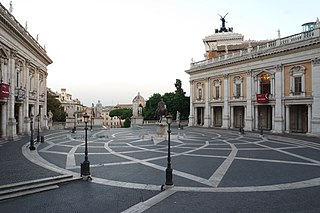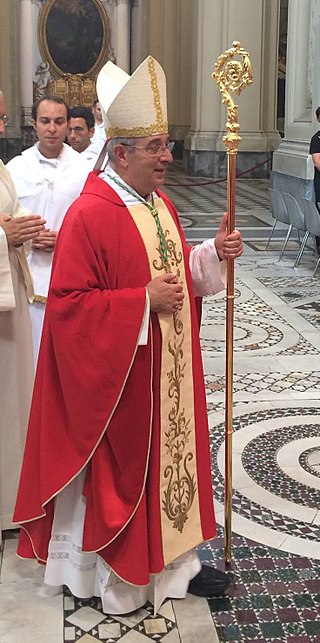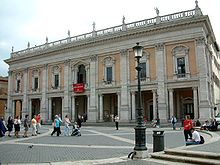
The Capitolium or Capitoline Hill, between the Forum and the Campus Martius, is one of the Seven Hills of Rome.

EUR is a residential and business district in Rome, Italy, part of the Municipio IX.

The Forma Urbis Romae or Severan Marble Plan is a massive marble map of ancient Rome, created under the emperor Septimius Severus between 203 and 211. Matteo Cadario gives specific years of 205–208, noting that the map was based on property records.

Velletri is an Italian comune in the Metropolitan City of Rome, approximately 40 km to the southeast of the city centre, located in the Alban Hills, in the region of Lazio, central Italy. Neighbouring communes are Rocca di Papa, Lariano, Cisterna di Latina, Artena, Aprilia, Nemi, Genzano di Roma, and Lanuvio. Its motto is: Est mihi libertas papalis et imperialis.

Rodolfo Amedeo Lanciani was an Italian archaeologist, a pioneering student of ancient Roman topography. Among his many excavations was that of the House of the Vestals in the Roman Forum.

The Capitoline Museums are a group of art and archaeological museums in Piazza del Campidoglio, on top of the Capitoline Hill in Rome, Italy. The historic seats of the museums are Palazzo dei Conservatori and Palazzo Nuovo, facing on the central trapezoidal piazza in a plan conceived by Michelangelo in 1536 and executed over a period of more than 400 years.

Piazza del Campidoglio is a public square on the top of the ancient Capitoline Hill, between the Roman Forum and the Campus Martius in Rome, Italy. The square includes three main buildings, the Capitoline Museums, Palazzo Senatorio and the Palazzo Nuovo. The hilltop square was designed by Michelangelo in the 16th century. Palazzo Senatorio is today the seat of the Municipality of Rome. The Capitoline Museums are the oldest public museums in the world. They are a group of art and archeological museums in the plaza that include Palazzo dei Conservatori and Palazzo Nuovo.

Antoniazzo Romano, born Antonio di Benedetto Aquilo degli Aquili was an Italian Early Renaissance painter, the leading figure of the Roman school during the latter part of the 15th century. He "made a speciality of repainting or interpreting older images, or generating new cult images with an archaic flavor", in particular by very often using the gold ground style, which was unusual by this period.
Filippo Coarelli is an Italian archaeologist, Professor of Greek and Roman Antiquities at the University of Perugia.

Cardinal Vicar is a title commonly given to the vicar general of the Diocese of Rome for the portion of the diocese within Italy. The official title, as given in the Annuario Pontificio, is Vicar General of His Holiness.

The Via Giulia is a street of historical and architectural importance in Rome, Italy, which runs along the left (east) bank of the Tiber from Piazza San Vincenzo Pallotti, near Ponte Sisto, to Piazza dell'Oro. It is about 1 kilometre long and connects the Regola and Ponte Rioni.

Romano Romanelli was an Italian artist, writer, and naval officer. He is best known for his sculptures and his medals.

Marphurius or Marforio is one of the talking statues of Rome. Marforio maintained a friendly rivalry with his most prominent rival, Pasquin. As at the other five "talking statues", pasquinades—irreverent satires poking fun at public figures—were posted beside Marforio in the 16th and 17th centuries.

The over-lifesize marble Dionysus with Panther and Satyr in the Palazzo Altemps, Rome, is a Roman work of the 2nd century AD, found in the 16th century on the Quirinal Hill at the time foundations were being dug for Palazzo Mattei at Quattro Fontane. The statue was purchased for the Ludovisi collection, where it was first displayed in front of the Palazzo Grande, the main structure of the Villa Ludovisi, and by 1641 in the gallery of sculptures in the Casino Capponi erected for Cardinal Ludovico Ludovisi in the villa's extensive grounds. By 1885, it had been removed to the new Palazzo del Principe di Piombino, nearby in via Veneto. With the rest of the Boncompagni-Ludovisi collection, which was open to the public on Sundays and covered in the guidebooks, and where it had become famous, it was purchased in 1901 for the City of Rome, as the Ludovisi collection was dispersed and the Villa's ground built over at the end of the 19th century.

Piazza d'Aracoeli is a square of Rome (Italy), placed at the base of the Capitoline Hill, in the Rione X Campitelli.

The Museo di Roma is a museum in Rome, Italy, part of the network of Roman civic museums. The museum was founded in the Fascist era with the aim of documenting the local history and traditions of the "old Rome" that was rapidly disappearing, but following many donations and acquisitions of works of art is now principally an art museum. The collections initially included 120 water-colours by the nineteenth-century painter Ettore Roesler Franz of Roma sparita, "vanished Rome", later moved to the Museo di Roma in Trastevere.

The Albertoni Spinola Palace, with entrances in Campitelli square n. 2, Capizucchi square and vicolo Capizucchi is located in the 10th District. It was projected and executed by Giacomo Della Porta and Girolamo Rainaldi around the end of 16th century and the first years of 17th century.
The Prior of the Caporioni was the caporione or capo rione of rione I of late medieval Rome.
Francesco Giubilei is an Italian publisher, columnist and conservative writer. Since 2022, he is a special advisor for the Italian Minister of Culture Gennaro Sangiuliano.
















